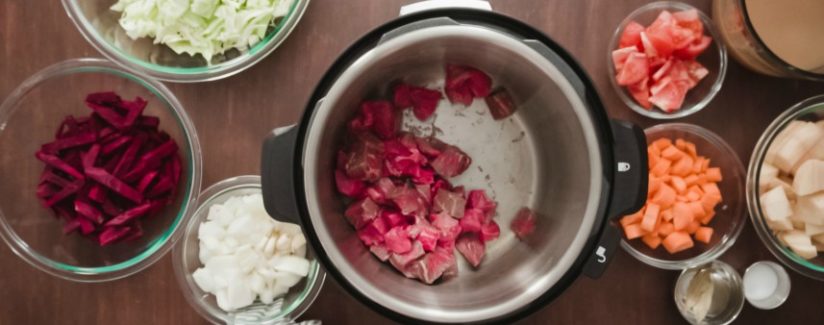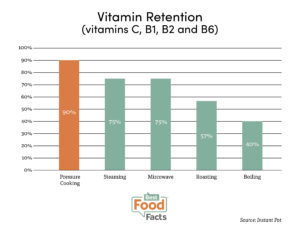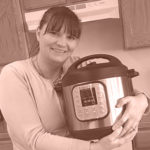
Thinking About Buying an Instant Pot?
You’ve probably heard of Instant Pots, but you might be wondering what it is and if it’s worth your money. An Instant Pot is the most popular brand name for a pressure cooker that has a wide array of other functions to help foodies create even more flavorful meals.
The Instant Pot and other pressure cookers can help making cooking easier—and more adventurous. The appliance can help you make your favorite dishes, like soup or slow-cooked meat, but can also make cheesecake, yogurt, and kettle corn. We reached out to University of Idaho Extension Educator Becky Hutchings for insight on the pressure cookers and their cooking potential.
Is the cost of purchasing one of these cooking appliances worth it?
Hutchings: “For me, my electric pressure cooker is worth every penny: it frees up space in my kitchen, minimizes dirty dishes, and allows me to cook meals quickly and with less planning. However, for some people, it might not be.
“If you prefer to do most of your cooking in the oven or barbecue and don’t use a pressure cooker, slow cooker, rice cooker, steamer, or any of the other appliances that electric pressure cookers replace, chances are, it will just collect dust on your shelf, and you might as well spend the money on an appliance that would be more beneficial to your cooking style.”
Is cooking with an Instant Pot or other pressure cooker healthier than eating regular cooked food?
Hutchings: “Pressure cooking retains many of the nutrients that can be lost during other methods of cooking. Contrary to what some people think, higher cooking temperatures don’t destroy any more nutrients than lower cooking temperatures. If a temperature is high enough to start destroying heat-sensitive nutrients, then those heat-sensitive nutrients will be lost regardless of whether the cooking temperature is 120F or 350F. It turns out it’s not the temperature that matters, but the cooking time! By cooking foods for shorter lengths of time, pressure cookers preserve the nutrients better, despite cooking at higher temperatures.” 
How does a pressure cooker actually work?
Hutchings: “You put food in the pot with usually a minimum of one cup liquid; which will allow the pot to build up an abundant amount of steam pressure. Once the lid is locked in place and the cooker temperature is set, steam develops inside the pot and cannot escape. The trapped steam increases the atmospheric pressure inside the cooker by 15 pounds per square inch (psi). This pressure results with food being cooked at about 250° F which is hotter than the normal boiling point (212° at sea level). This elevated pressure allows for a faster cooking process than conventional cooking and since very little moisture is lost, which makes for less liquid being required, this process produces more intense flavors. Lastly, it also allows more vitamins to be retained in your food during the cooking process.”
How do Instant Pots provide a different experience for cooking at home?
Hutchings: “Electric pressure cookers allow today’s cooks the ability to put meals on the table in a matter of minutes and just because they are quick cooking doesn’t mean that you compromise on the taste and flavor.
“The pressure cooker can make a one-pot meal by allowing the consumer to sauté and cook the food in the same dish, so clean-up is a breeze. Meals in the electric pressure cooker can even be stacked so it is cooking two or three dishes in a single pot. Some electric pressure cookers also have additional features to use it as a slow cooker or a yogurt maker.”
Are there any concerns consumers should address before buying these products for their own home?
Hutchings: “There are currently several brands of electric pressure cookers available. Each of these different brands of electric pressure cookers offers different models and sizes of multicookers.”
Here are some key factors to consider:
- Frequency of use – How often do you plan to use it to prepare meals? If you want to use it to make every meal that your family will eat in a day, you may want to consider purchasing more than one inner cooking pot to avoid the need to wash dishes after every use.
- How many people are you feeding? If you will typically cook meals for 4 people or less, a 6-quart size electric pressure cooker should suffice. If you have a larger family or you like to prepare large roasts or batch cook, you should consider purchasing an 8-quart size or larger.
- Desired features – Almost all brands of multicookers on the market have functions for electric pressure cooking, slow cooking, steaming, sautéing and making rice. Some models include additional settings, such as yogurt making and air frying technology.
- Budget – Electric pressure cookers vary in cost, but on average, you can expect to pay $60 – $300, dependent on brand and model desired.
When using new cooking appliances, you should be aware of foodborne illnesses related to poor cooking practices. Francisco Diez-Gonzalez, Professor and Director of the Center for Food Safety at the University of Georgia, shared some tips for consumers interested in purchasing new food technology appliances.
“Pot pressure cookers are one of the kitchen electronic devices that poses one of the lowest food safety risks because the temperature that the food item reaches normally kills most pathogenic organisms,” Dr. Diez-Gonzelez said. “The only concern with a pressure cooker would be if the consumer does not follow the manufacturer’s recommendation and mishandles the food after it has been cooked. One possible risky scenario could be if the food is cooked and is left in the cooker for many hours without any heating. This could potentially create an ideal condition for bacteria that form spores, which survive cooking to grow to dangerous levels.”
Cooking with a pressure cooker opens the door for more opportunities and provides an all-in-one appliance experience. This appliance also has a higher nutrient retention than other cooking methods, and saves the consumer money, time, and energy in the kitchen.



























